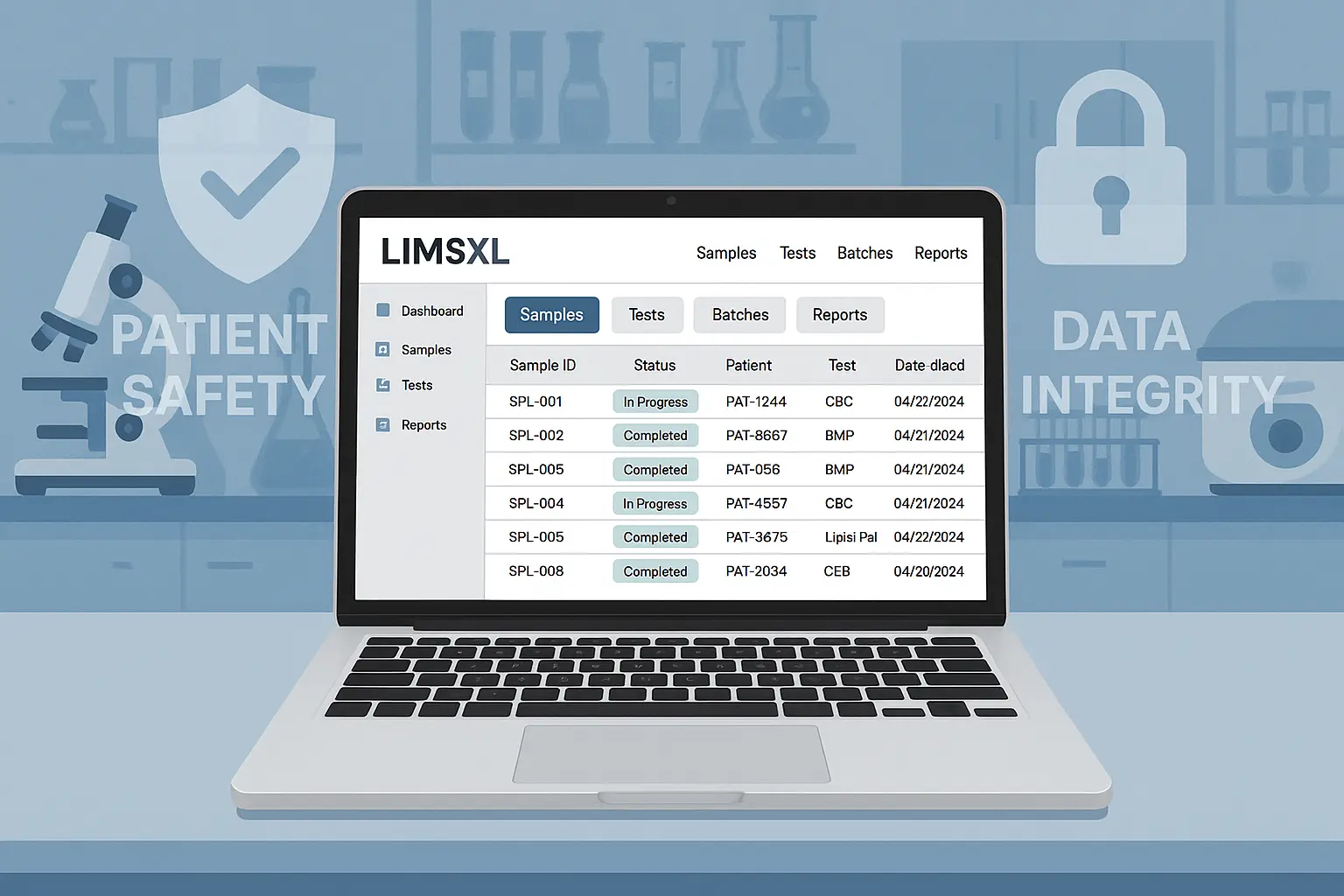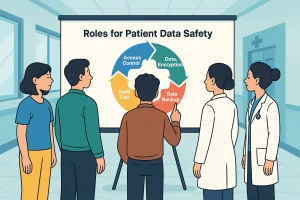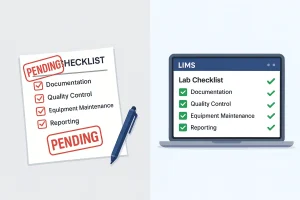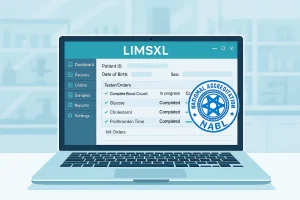In modern healthcare systems, protecting patient safety and preserving data confidentiality has become extremely critical, particularly in diagnostic areas such as pathology labs. Effectively corroborating diagnoses is reliant upon the strong ability to handle the collecting, processing, and storing of relevant patient data. One of the most potential and easiest ways to achieve this is through a Laboratory LIMS which automates several functions within the laboratory while meeting requisite compliance regarding the safeguarding of sensitive information.
In this blog, we will explore how LIMS lab system contributes to patient safety and data integrity.
Current Status of LIMS System Implementation in India
As per the research report published by International Journal for Multidisciplinary Research, by the end of 2024, significant government initiatives and investments advanced the use of LIMS System in India, transforming the healthcare sector. The country’s increasing reliance on LIMS impacted key areas like pharmaceuticals and biotechnology. Sustainability goals were also supported, with 20% of laboratories adopting eco-friendly LIMS solutions, reducing paper usage and promoting electronic data management.
What is LIMS System?
A Laboratory Information Management System (LIMS) is a software module system designed to enhance the workflow and operations of medical and diagnostic laboratories. It automates the management of patient data, samples, testing, processing, reporting, and inventory control. Digitization of these activities enhances the accuracy, efficiency, speed of services provided, leading to timely and reliable diagnostic result.
One of the key features of LIMSXL, developed by Image Computers, is its customizability, making it an ideal choice for pathology labs of any size. LIMSXL ensures the seamless integration of laboratory operations, providing pathologists and technicians with the tools they need to improve productivity while maintaining high standards of patient safety and data integrity.
How LIMS System Ensures Patient Safety
As per the report published by American Journal of Laboratory Medicine several areas of patient safety can see improvements with the right rollout of LIMS. Each phase in LIMS system involves different tasks that supports and affects quality and safety. There are many examples of Laboratory LIMS functions that enhance safety, such as data storage, clinical workflow management, specimen tracking, rule-based verification, alerts, bar coding, result viewing, result presentation, charting, and instrument interfaces. Additionally, it can help reduce diagnostic errors across the pre-analytic, analytic, and post-analytic phases.
Here’s a table that explains how a lab software helps improve patient safety in different stages.
| LIMS Function | Safety Issue | Improvement |
| Data repository | Documentation | Better data integrity, accuracy, completion, consistency, precision, and quality |
| Computerized Provider order entry | Inconsistent requisitions | Eliminate illegibility, consistency, providing relevant clinical information |
| Rule-based verification | Incomplete test results | Eliminate release of incomplete test results Alerts |
| Alerts | Common preventable errors | Notify physicians of common issues |
| Bar coding | Specimens mix up | Eliminate errors in specimen labelling, handling and patient mix up |
Sample Tracking and Identification
One of the primary functions of a LIMS system is sample tracking. The LIMS lab system ensures that each sample is accurately logged from collection through testing and analysis. This eliminates the risk of mix-ups, where a sample might be incorrectly assigned to the wrong patient, a problem that could otherwise lead to erroneous diagnoses and delayed treatments.
LIMSXL a product of Image Computers (A subsidiary of Mechsoft Digital Technologies) enables pathology labs to track each sample in real time using barcodes, ensuring that each sample is correctly matched with the right patient. By integrating barcode scanning and automated sample logging, LIMSXL minimizes the risk of human error, ensuring that all samples are processed and reported accurately.
Integration with Diagnostic Equipment
Many modern LIMS systems, including our LIMS lab system LIMSXL, integrate seamlessly with laboratory equipment, ensuring that test results are automatically entered into the system. This integration allows for faster, more accurate reporting of results, reducing the possibility of transcription errors that could impact patient safety.
Moreover, this integration supports NABL-compliant workflows, ensuring that the lab adheres to national standards for testing accuracy and quality. By automating the collection and recording of test results, our laboratory LIMS significantly reduces human intervention, making the process more secure and reliable.
Access Control and Security
Security is essential for keeping patients safe. LIMS systems like LIMSXL make sure that only authorized staff can access sensitive patient information. They do this through role-based access controls. Each user, such as technicians, doctors, and lab managers, gets specific access based on their job in the lab.
Our lab software LIMSXL offers robust security features, such as password protection, encrypted data storage, and secure data transfer protocols, ensuring that patient information is always kept safe and confidential.
How LIMS System Ensures Data Integrity
Data integrity is the foundation of reliable healthcare. Accurate and timely data management ensures that healthcare providers can make informed decisions, and patients receive the best care possible. LIMS systems play a key role in ensuring data accuracy and reliability.
Automation and Error Reduction
One of the main ways LIMS systems ensure data integrity is by automating data entry, reducing the risk of human error. Manual data input increases the risk of errors, compromising test result accuracy. By automating the process, LIMSXL eliminates transcription errors and ensures that patient information is consistently accurate throughout the testing and reporting stages.
For example, our LIMSXL automatically captures data from laboratory instruments and integrates it directly into the system, reducing the chances of errors that might occur when transferring data manually. This integration ensures that test results are accurate, up-to-date, and ready for analysis.
Audit Trails and Traceability with LIMS Lab System
To comply with regulatory standards, LIMS systems must maintain comprehensive audit trails that document all actions taken within the system. These logs include changes to patient data, test results, and who made the changes. LIMSXL offers robust audit trail functionality, which allows labs to trace every step of the process, ensuring accountability and transparency.
Real-Time Data Access and Backup
Real-time data access lets lab staff and healthcare providers get the latest test results without delay. LIMSXL provides this access, enabling medical teams to make prompt decisions based on current patient information.
Our lab software LIMSXL also conducts regular backups to prevent data loss from system failures or other unexpected events. This keeps lab data safely stored and allows for recovery in emergencies, protecting data integrity at all times.
Conclusion
For labs looking to enhance their data integrity and patient safety, adopting a reliable LIMS system like LIMSXL is the key to improving diagnostic accuracy, ensuring regulatory compliance, and providing better healthcare outcomes.
Whether you are looking to improve the accuracy of your lab results, ensure compliance with regulatory standards, or streamline your operations, LIMSXL offers a robust, customizable solution designed to meet the unique needs of modern pathology labs.
If you’re interested in learning more about how LIMSXL can transform your pathology lab, request a demo today to experience the power of this laboratory LIMS system in action!




